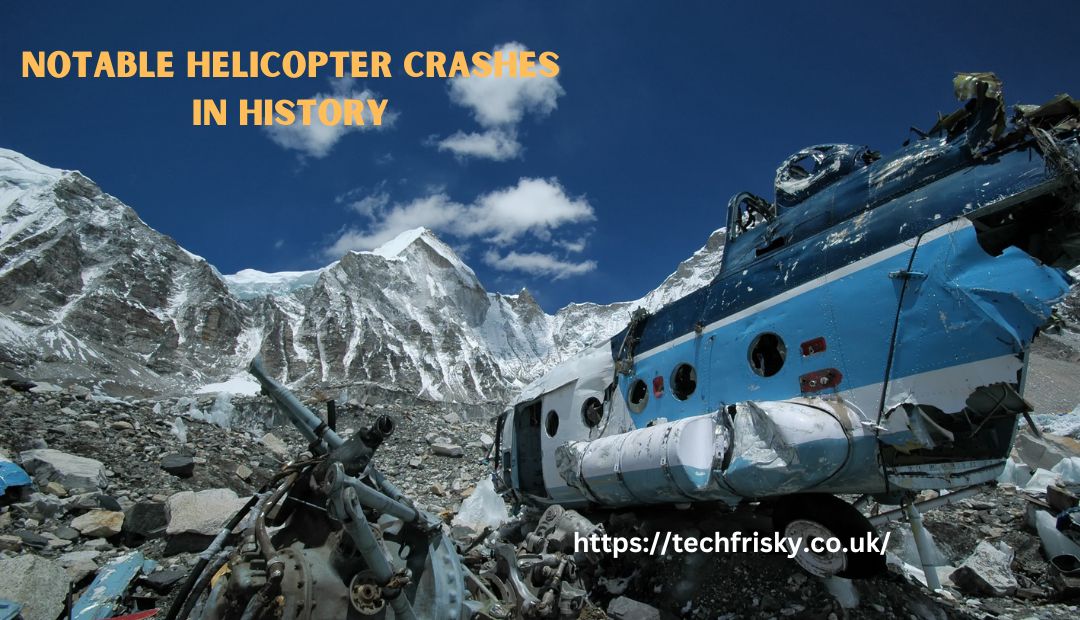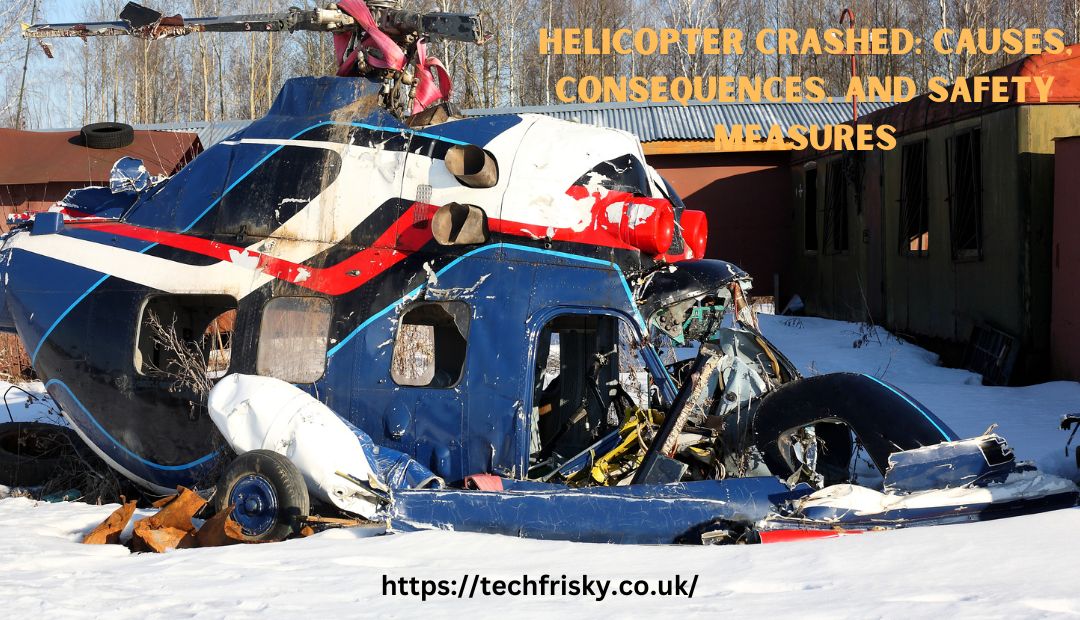The helicopter crashed, while rare compared to other modes of transportation, have a significant impact due to the serious risks they pose to both passengers and those on the ground. This article explores the various factors that lead to helicopter crashes, the consequences they bring, and the critical safety measures that can help prevent such incidents.
The Anatomy of a helicopter crashed
How Helicopters Operate
The helicopter crashed are unique in their ability to take off and land vertically, hover, and move in any direction. This versatility makes them invaluable in various industries, from emergency medical services to military operations. However, this same complexity in design can also contribute to the risk of a crash if not properly managed.
Mechanical Failures as a Leading Cause
Helicopter crashes are frequently caused by mechanical breakdowns. These can range from engine malfunctions to issues with the rotor blades or tail rotors. Even minor mechanical issues can lead to catastrophic results in the air. Regular maintenance, thorough inspections, and adhering to safety protocols are vital to preventing accidents caused by technical problems.
Human Error in Helicopter Crashes
Human error plays a significant role in many helicopter crashes. Pilots must be highly trained and vigilant, but even with experience, errors in judgment, miscommunication with air traffic control, or failure to adhere to weather warnings can lead to disastrous outcomes. Studies have shown that human error accounts for a large percentage of aviation accidents, including helicopter incidents.
Factors Contributing to Helicopter Crashes
Adverse Weather Conditions
Weather is a critical factor in helicopter crashed. Helicopters are more susceptible to dangerous weather conditions than fixed-wing aircraft. Factors such as strong winds, low visibility, rain, or snow can significantly increase the risk of an accident. Poor weather conditions can disorient pilots, leading to what is known as spatial disorientation, where pilots lose track of their altitude and orientation in the sky.
Controlled Flight Into Terrain (CFIT)
CFIT occurs when an aircraft, under the control of the pilot, inadvertently crashes into terrain like mountains, hills, or water due to poor visibility or navigational errors. This is particularly dangerous for helicopters operating in rugged environments or during rescue missions in areas with difficult terrain.
Pilot Fatigue and Stress
Fatigue is a common issue in aviation, and helicopter pilots are no exception. Long hours, challenging conditions, and the intense concentration required for flight can lead to pilot exhaustion. Stress from tight schedules, emergency operations, or military missions can also impact decision-making abilities, increasing the risk of a crash.

Notable Helicopter Crashes in History
Kobe Bryant Helicopter Crash (2020)
One of the most tragic and high-profile helicopter crashed occurred in January 2020, when a Sikorsky S-76 helicopter carrying basketball legend Kobe Bryant, his daughter Gianna, and seven others crashed into a hillside in Calabasas, California. Poor weather conditions, including heavy fog, were identified as key contributing factors, leading to spatial disorientation by the pilot.
1993 Friendly Fire Incident (Black Hawk Down)
During the U.S. military’s Operation Gothic Serpent in Somalia, two Black Hawk helicopters were shot down, leading to the infamous Black Hawk Down incident. This tragic event highlighted the risks military helicopters face in hostile environments and led to a re-evaluation of tactics and aircraft defense mechanisms.
Immediate Consequences of Helicopter Crashes
Loss of Life and Injuries
Helicopter crashes often result in fatalities or severe injuries due to the nature of the crash. Passengers, crew members, and even bystanders can be affected, leading to significant loss of life. Survivors may suffer from traumatic injuries that require long-term medical care.
Environmental Damage
In some cases, helicopter crashed can cause environmental damage, especially if the crash occurs in sensitive ecosystems or involves the spillage of fuel or other hazardous materials. Fires caused by crashes can spread quickly, especially in dry or forested areas, adding to the devastation.
Economic Impact
The economic consequences of helicopter crashed are substantial. They include the loss of expensive aircraft, damage to property, legal costs from lawsuits, and the potential for increased insurance premiums for companies operating helicopters. In cases involving commercial operations, the reputational damage can also lead to significant financial losses.
Safety Measures to Prevent Helicopter Crashes
Regular Maintenance and Inspection
Ensuring that helicopters are well-maintained is crucial in preventing mechanical failures that can lead to crashes. Routine inspections, adherence to manufacturers’ guidelines, and immediate repairs for even minor issues are vital. Technicians must be certified and trained to handle the complex systems involved in helicopters.
Pilot Training and Certification
Pilot error is a significant contributor to helicopter crashed, so rigorous training and certification are essential. Pilots should be trained not only in handling standard flight conditions but also in managing emergency situations, bad weather, and night flying. Continuous education and refresher courses can keep pilots up to date with the latest safety protocols and technologies.
Use of Advanced Flight Systems
Modern technology can help prevent helicopter crashed. Advanced flight control systems, GPS navigation, and weather radar systems can assist pilots in navigating tough conditions. The installation of terrain awareness and warning systems (TAWS) and traffic collision avoidance systems (TCAS) can provide additional layers of safety.
Improved Communication and Coordination
Effective communication between pilots and air traffic control is essential for safe helicopter operations. Coordinating flight paths, avoiding restricted zones, and receiving updates on changing weather conditions can help prevent accidents. In military operations or rescue missions, strong coordination among teams is especially important.
Investigations and Crash Response
Role of Aviation Authorities
In the aftermath of a helicopter crashed, aviation authorities like the National Transportation Safety Board (NTSB) in the U.S. and similar organizations worldwide are responsible for conducting thorough investigations. Their job is to ascertain whether the crash was caused by a combination of circumstances, human error, mechanical failure, or weather.
Importance of Black Box Data
Many helicopters are equipped with flight data recorders, commonly known as black boxes, which capture critical information about the flight before the crash. This data is invaluable in helping investigators understand what happened and how to prevent similar crashes in the future.
Search and Rescue Operations
Search and rescue teams play a crucial role in the immediate aftermath of a helicopter crashed. These teams are often deployed to locate survivors and recover wreckage in remote or difficult-to-access areas. Their ability to respond quickly can be the difference between life and death for those involved in the crash.
Frequently Asked Questions
What Causes Most Helicopter Crashes?
The leading causes of helicopter crashes include mechanical failures, human error, and adverse weather conditions. Pilot fatigue and spatial disorientation also contribute to accidents, especially during complex or high-stress operations.
How Safe Are Helicopters Compared to Airplanes?
While helicopter crashed are generally safe, they are more vulnerable to certain conditions like strong winds and poor visibility due to their design. Helicopters also perform more complex maneuvers, such as hovering and landing in challenging terrains, which can increase the risk of crashes compared to airplanes.
Can Mechanical Failures Be Prevented?
Yes, regular maintenance and thorough inspections can prevent many mechanical failures. Adhering to manufacturers’ guidelines and addressing even minor technical issues promptly is crucial for maintaining helicopter safety.
What Should I Do If I Witness a Helicopter Crash?
If you witness a helicopter crashed, contact emergency services immediately and provide them with the location of the crash. Avoid approaching the crash site, as there could be risks of fire, hazardous materials, or explosions.
How Are Helicopter Crashes Investigated?
Helicopter crashes are investigated by aviation authorities, who analyze black box data, interview witnesses, and inspect wreckage to determine the cause of the crash. Their findings help improve safety protocols to prevent future accidents.
Are Helicopter Crashes Common?
Helicopter crashes are relatively rare compared to other types of transportation accidents. However, when they do occur, they can be more fatal due to the nature of helicopter crashed operations and the environments in which they often fly.
